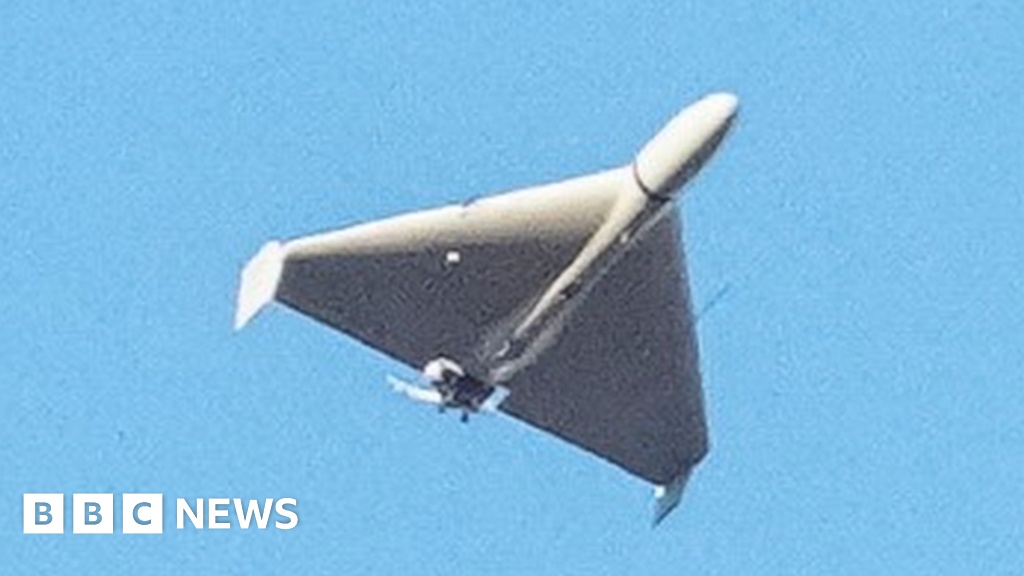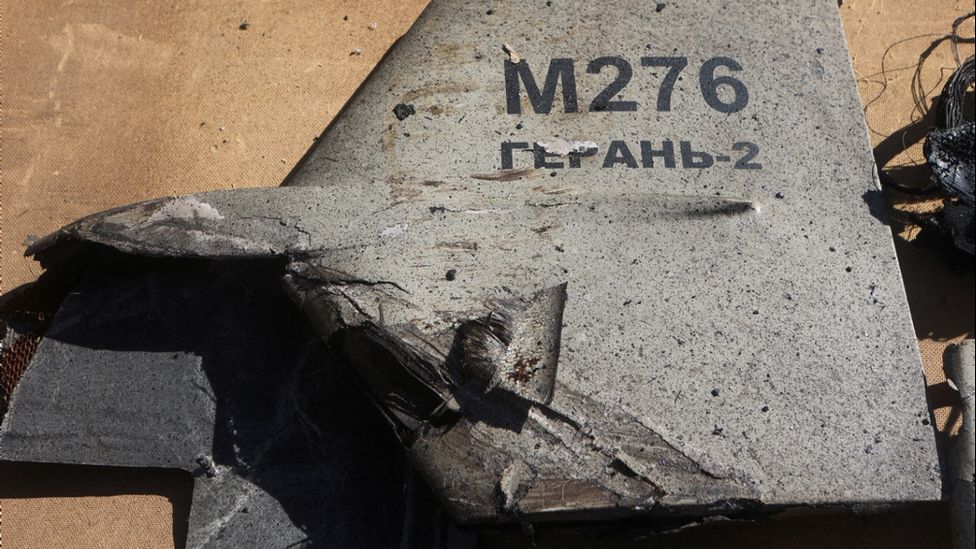

Wreckage of a Shahed-136 (or Geranium-2) kamikaze drone shot down by the Ukrainians
Ukraine has accused Russia of using “kamikaze” drones against civilian targets in Kyiv.
These carry explosives which detonate on impact, destroying the drone in the process.
What is Russia’s ‘kamikaze’ drone?
It’s believed Russia has been using the Iranian-made Shahed-136 drone in the Ukraine conflict since mid-September.
Also called the Geranium-2 by Russia, it has explosives in a warhead on its nose and is designed to loiter over a target until it is instructed to attack.
The Shahed-136 has a wingspan of about 2.5m (8.2ft) and can be hard to detect on radar.
It’s unclear exactly how many Russia has, but the US has said Iran planned to send hundreds to Russia. Iran has denied doing so.
What damage have kamikaze drones done in Ukraine?
Russia was first reported to have used a Shahed-136 drone on 13 September, attacking targets near Kupiansk, a city in the Kharkiv region in the east of the country.
Later that month, it was used in attacks in the south. Debris from the drones were found in wreckage in Odesa and Mykolaiv.
In October, Shehab-136 drones landed on civilian areas in the city of Bila Tserkva, south of Kyiv.
Russia may be using these drones rather than cruise missiles because they are relatively cheap – about $20,000 (£17,800) each.
How is Ukraine trying to combat them?
However, it is hard to shoot them all down.
“They fly low and you can send them in waves. These swarms of drones are much harder to counter by air defences,” military expert Justin Crump told the BBC.
Has Ukraine used ‘kamikaze’ drones?
It’s not clear whether these have been used by Ukraine, but experts believe they may have been deployed in recent attacks on a Russian military base in western Crimea, on an airbase near Sevastopol, and on ships in Sevastopol harbour.
Dr Marina Miron, researcher in defence studies at King’s College London, says: “If you look at the explosions in the attacks, they are quite small. I suspect that these are homemade drones, which have had explosives strapped to them.”
What other drones do Ukraine and Russia have?
Ukraine’s main military drone is the Turkish-made Bayraktar TB2. It is about the size of a small plane, has cameras on board, and can be armed with laser-guided bombs.
At the outset of the war, Ukraine had a fleet of “fewer than 50” of these, says Dr Jack Watling of the Royal United Services Institute (Rusi) think-tank.
Russia also uses the “smaller, more basic” Orlan-10, which have cameras and can carry small bombs.
How have military drones been used?
For both sides – Russia and Ukraine – drones have been effective for locating enemy targets and guiding artillery fire toward them.
“Russian forces can bring their guns to bear on the enemy within only three to five minutes of an Orlan-10 drone spotting a target,” says Dr Watling. An attack could otherwise take 20-30 minutes to carry out.
Dr Marina Miron says drones have allowed Ukraine to stretch its limited forces.
“If you wanted to seek out enemy positions in the past, you would have had to send out special forces units… and you might lose some troops,” she says. “Now, all you’re risking is a drone.”
Russian Orlan-10 drones can target artillery fire on enemy positions within minutes
In the first few weeks of the war, Ukraine’s Bayraktar drones were widely praised.
However, the Bayraktar is a large and slow moving drone, and Russia has been able to counter it effectively with its air defence systems.
How are the non-military drones being used?
Military drones are expensive to replace – a single Bayraktar TB2 costs about $2m (£1.7m).
So, both sides – but especially Ukraine – also use small, commercial models, such as the DJI Mavic 3, which costs about £1,700.
These commercial drones can be fitted with small bombs. However, they are mainly used to spot enemy troops and to direct attacks.
“Ukraine doesn’t have as much ammunition as Russia,” says Dr Miron. “Having ‘eyes in the sky’ to spot targets and direct artillery fire means they can make better use of what they have.”
But commercial drones are much less capable than military ones.
For example, the DJI Mavic’s total flying distance is only 30km, and it can only fly for a maximum of 46 minutes.
Russia is using electronic devices to counter them, says Dr Miron.
“Russian forces have the Stupor rifle, which shoots electromagnetic pulses,” she says. This stops commercial drones from being able to navigate using GPS, she explains.
Watch: The volunteers using drones to monitor Russian troops
These systems can cause a drone to crash or return to base, and can stop it sending back information.
